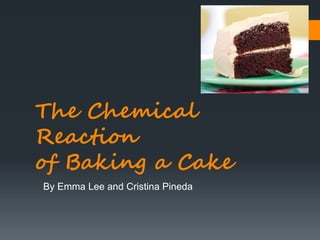
Cake
- 1. The Chemical Reaction of Baking a Cake By Emma Lee and Cristina Pineda
- 2. Ingredients and How They React Flour- is the main ingredient, which is made up of mostly protein and starch. It is the bulk of the cake. Yeast-plant that feeds on sugars and starches and releases CO2, alcohol and sugar. Fat-gives a soft texture and prevents the CO2 and the yeast from escaping the mixture. Sugar- is the food source for the yeast, it also causes the cake to turn golden brown, known as the Maillard reaction. Sugar also gives the cake flavor. Baking Soda or Baking Powder-is a neutralizer, it helps the yeast produce CO2, it is also called sodium bicarbonate, and its chemical formula is 2NaHCO3 Egg-gives the cake a light airy texture, it also is a binder and makes the cake stronger, when it is cooked the protein molecules become uncurled and create molecular bonds with other protein molecules that are nearby.
- 3. Adding Heat When adding heat the chemicals undergo molecular changes The baking soda (sodium hydrogen carbonate) changes to: Sodium carbonate Carbon dioxide Water This Process gives the cake little holes and makes it fluff This is the Formula: 2 NaHCO3 → Na2CO3 + H2O + CO2
- 4. A Second Reaction A browning occurs when sugars are introduced to heat This is called MAILLARD REACTION A reaction of sugar and heat that produces a browning effect at 160 degrees Celsius or higher. This effect was first noticed by the French Biochemist Louis Camille Maillard, and was named after him.
- 5. Baking a Cake is a Chemical Change When a cake is baked you can tell it’s a chemical change because it cannot go back to the original state that it was in. The form of the cake before it is baked is batter and when heat is added it turns fluffy and sponge like, it puffs up and has air bubbles. There is color change because of the Maillard Reaction There is also odor, it smells yummy after it’s baked